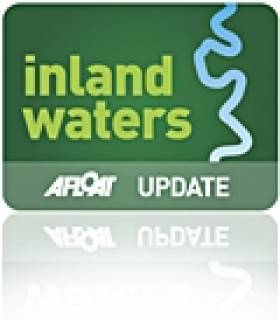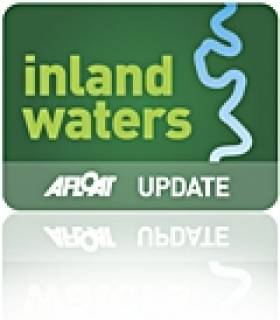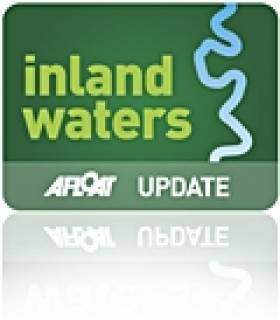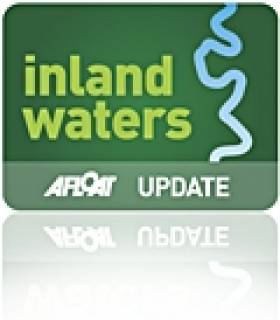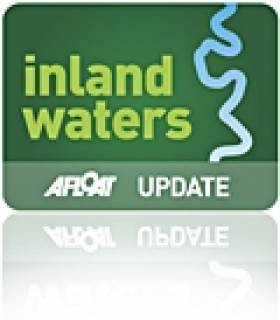Displaying items by tag: inland waters
Low Water Levels Advisory For Ireland's Inland Navigations
#InlandWaters - Despite the threat of floods amid the current weather warning, the recent extended period of dry weather has meant that water levels in Ireland's navigable inland waterways are lower than normal for this time of year.
Where water levels fall below normal summer levels, Waterways Ireland says masters should be aware that their vessels may be at risk of grounding, particularly deep drafted vessels.
To reduce this risk, masters should navigate where possible on or near the centreline of the channel and also avoid short cutting in dog-legged channels and navigating too close to navigation markers.
Proceeding at a slow speed will also reduce 'squat' effect, ie where the vessel tends to sit lower in the water as a consequence of higher speed.
Low water levels will also impact on slipways, with reduced slipway length available under the water surface and the possibility of launching trailers dropping off the end of the concrete apron onto the river/lake bed and causing damage to trailer, outboard motor or boat.
More slipway surface will also be susceptible to weed growth requiring care while engaged in launching boats.
Very dry riverbanks are more susceptible to erosion from vessel wash. Waterways Ireland asks masters to ensure they adhere to the speed limits and maintain a reduced wash.
Where appropriate by maximising on the number of vessels in a lock the total volume of water moving downstream is decreased. This also reduces the volume of water used.
Waterways Ireland asks users to be patient and wait for other boaters to share the lock rather than using locks for single passages.
Masters are also requested to make sure lock cycles are used for vessels travelling each way. Each lock cycle should take boats both up and down stream. All sluice gates and paddles should be shut when leaving a lock.
In addition, masters are reminded not to leave taps running at watering points or service blocks in the interest of water conservation.
Inland Waters Notices: Canoe Polo Nationals, Shannon Boat Rally & Lanesborough Swim Race
#InlandWaters - Masters and owners of vessels on the western end of the Royal Canal are advised of navigation restrictions this weekend (Sat 19 and Sun 20 July) during the National Canoe Polo Championships at Richmond Harbour in Clondra, Co Longford.
Traffic management will also be in place in Athlone during the Shannon Boat Rally between Saturday 26 July and Sunday 3 August, with boats transiting from Lough Ree to Shannonbridge towards Ballinasloe during this period.
Masters should allow extra time for lock passage at Athlone when the rally is moving south due to the large number of vessels expected.
Elsewhere on the Shannon Navigation, an open water swimming race will take place from the Bord na Mona railway bridge, some 3km upstream of Lanesborough, to Lanesborough bridge on the August Bank Holiday (Monday 4 August) from 1.30pm to 4.30pm.
All masters and owners are requested to proceed at slow speed with minimum wash when passing this stretch of the navigation and note any advice given by race stewards and safety boat crew associated with the event.
Fish Farm Taps Lake For Disease Treatment Without Permission
#FishFarm - No council permission was given for a pipeline laid last month to extract water from Loughaunore to a nearby salmon farm in Kilkieran Bay in Co Galway, as the Connemara Journal reports.
Marine Harvest Ireland installed the 3.25km pipeline to help treat an outbreak of amoebic gill disease among its farmed salmon, but did so before a decision was made by Galway County Council over an exemption for the project from the usual planning permission requirements.
It's also claimed by Irish Water that despite a claim in Marine Harvest Ireland's Section 5 application that it has an 'agreement' with the new water metering body, no such agreement exists.
While extraction of potentially millions of litres of water from the lake has paused for now, local campaigners argue that the situation is typical of problems connected with fish farming - the subject of much controversy in the county since the furore over the planned large-scale organic salmon farm for the Aran Islands.
The Connemara Journal has much more on the story HERE.
'A Taste Of Lough Derg' Promotes Lakelands Food Producers
#InlandWaters - Food producers and restaurant owners surrounding Lough Derg have joined forces in an effort to promote the Lakelands region as a food tourism destination.
A Taste of Lough Derg 2014 is the brand for the pilot initiative that features 13 separate food events taking place in villages and towns along the shores of Lough Derg in counties Clare, Galway and Tipperary from this month till September.
Things gets started tomorrow 13 July in Portumna, right at the top of Lough Derg, when local food producers Sunny Meadow Farm and Killeen Cheese team up for a BBQ and cheese tasting event.
That's followed in the coming days by a 'taste and make' chocolate day at Wilde Irish Chocolates in Tuamgraney, Co Clare, a 'pizza picnic' at River Run House, where the Shannon meets Lough Derg in Terryglass, Co Tipperary, and much more to come.
A brochure with much more about the initiative and planned events over the summer is available to read or download HERE.
Minister Opens Royal Canal Path Between Ashtown & Casteknock
#RoyalCanal - The Royal Canal path from Ashtown to Castleknock is the latest section of the ambitious Dublin-Galway coast-to-coast greenway to open, with Transport Minister Leo Varadkar cutting the ribbon on the 2.5km stretch today at the 12th Lock (Friday 27 June).
The €2 million section across West Dublin is intended to be valuable local amenity for walkers, cyclists and other local residents - but it will also form part of the first national greenway running right across the country, from the Dublin Docklands to the Atlantic coast in Galway.
In addition, Minister Varadkar announced details of the preferred route for the western section of the greenway between Athlone and Galway, running through Shannonbridge, Loughrea, Craughwell, Clarinbridge and Oranmore to the Galway coast.
“It’s great to see the Galway to Dublin Greenway taking shape," he said. "Two years ago we only had a simple idea to run a greenway along the Royal Canal. Now three sections are open to the public and being used actively by walkers, cyclists and for other leisure pursuits."
The minister elaborated on the "incremental approach" for the greenway project, developing sections as funding becomes available.
"Although we still have a huge task in finishing the rest of the project, I’m really looking forward to walking, cycling or running along the entire route between Dublin and Galway when it’s finally completed.”
Opened so far, along with the Ashtown-Castleknock path, are the section from Guild Street to Sherriff Street in Dublin's Docklands, and a 25km route in Westmeath from Mullingar to the Meath border.
A 40km section between Mullingar and Athlone will be completed next year, after €4 million was allocated by Minister of State for Transport Alan Kelly. Two further sections totalling 40km in Kildare and Meath are at shovel-ready stage and work will start as soon as funding becomes available.
Two Prosecuted Over Illegal Fishing Incident On River Boyne
#Angling - Inland Fisheries Ireland (IFI) was successful in a court case brought against two men accused of illegal fishing and impeding authorised officers of IFI on the River Boyne in 2013.
At Navan District Court on 28 May, David Tuite of Drogheda, Co Louth was fined €400 for impeding an IFI authorised officer and ordered to pay total costs of €683 to IFI within six months, with 40 days imprisonment in default of payment.
Meanwhile, John O’Brien, also of Drogheda, was fined €800 for impeding an IFI authorised officer and ordered to pay costs of €683 to the IFI within six months, with 50 days imprisonment in default of payment.
The court heard that after midnight on 8 August 2013, fisheries officers Kevin O’Brien, Val Woods, Robert Bergin and Philip Duff from the Drogheda district were undertaking a covert surveillance operation following reports of illegal fishing at Proudfootstown, Co Meath.
They detected a number of men including David Tuite and John O’Brien who were acting suspiciously on the River Boyne and who were suspected of attempting to take fish illegally.
When intercepted by IFI staff, one of the men impeded the officers by throwing a bag he was carrying into the river, while the second man attempted to run away and refused to give his name when required to do so by the officers.
Both men were present at Navan District Court and pleaded guilty to impeding authorised officers in carrying out their duties in the execution of powers under Section 301 (7) of the 1959 Fisheries Consolidation Act.
Judge Conal Gibbons was very forceful in his support of the actions of IFI staff on the night in question. He stated that fisheries officers carry out difficult work in difficult places at unsociable hours.
He commended the work of officers O’Brien, Woods, Bergin and Duff, and stated that people should not interfere with the work of fisheries officers in the execution of their duties.
The River Boyne was one of the most salmon-prolific rivers on the East Coast, and in the 1980s approximately 10,000 salmon ran the system. This declined to an all-time low in 2006 when less than 1,000 salmon were caught on the river.
In 2006, IFI introduced a series of conservation measures in order to combat the decline in salmon numbers. The River Boyne is open for catch and release angling in an effort to conserve our native population of Atlantic salmon.
IFI has a Freefone number for the public to report poaching and pollution incidents at 1890 34 74 24 or 1890 FISH 24.
Heritage Canal Boat Is Making A Special Delivery
#Heritage - Some 119 years after she first plied her trade as a cargo boat on Ireland's inland waterways, heritage boat number 4E has been pressed back into service to make a special delivery to Enniskillen.
Some weeks ago, in Tullamore Harbour on a bright May morning, an ancient Bolinder engine was loaded onto 4E's front deck, and so began a journey that will take three months along various canals and rivers, eventually leading to the delivery of her cargo to the Waterways Ireland headquarters in Enniskillen.
Early in the last century the Bolinder engine replaced the tow-path heavy horses as the means of propulsion for these trading boats. This engine is being presented on extended loan by the Heritage Boat Association (HBA) to Waterways Ireland for display in their headquarters.
It was thought only fitting that the engine would be delivered by a heritage cargo boat, thus saluting the hundreds of boats and their crews who worked on the inland waterways over the centuries.
The journey continued west along the Grand Canal to the River Shannon, where 4E turned north to Athlone and onward through Lough Ree to Carrick-on-Shannon. Travelling north-east, the boat and cargo then traversed the Shannon-Erne Waterway via the Woodford River to Lough Erne.
Last weekend 4E and her cargo were due in Shannon Harbour, close to Banagher, to attend the Shannon Harbour Canal Boat Rally. This annual rally, which took place over the weekend of 20-22 June, was organised by the Shannon Harbour branch of the Inland Waterways Association of Ireland (IWAI).
There she was joined there by many other heritage cargo boats, most of which were also set to travel on to Enniskillen as part of the heritage fleet.
Members of the HBA are particularly interested in meeting with people whose families would have had connections with the commercial trade on the canals and rivers. For information contact Paul Martin at [email protected].
Arklow RNLI To Feature In RTÉ Series 'Abhainn'
#RNLI - Volunteers from Arklow RNLI in Co Wicklow are to feature in RTÉ's Irish language programme Abhainn.
The TV series features the rivers of Ireland, and this episode (to be broadcast in September) looks at the Avoca River from its source high up in Wicklow Mountains to the river mouth at Arklow.
An RTÉ film crew spent the afternoon and evening of Thursday 5 June filming at what is the oldest of the RNLI's lifeboat stations in Ireland.
During the day the film crew had the opportunity to experience firsthand and get a glimpse of the level of training required by the highly skilled and efficient RNLI volunteers in their lifesaving work, which can often be difficult and sometimes dangerous.
New station operations manager John Tyrrell said: "Filming with RTÉ was a great opportunity to showcase the commitment of volunteers not only in Arklow but in the many other coastal and inland water communities across Ireland."
He added that the RNLI wouldn’t exist without fundraising. The charity is totally reliant on the generosity of the public and indebted to the work of fundraisers at station branches as well as those raising money inland.
"It is because of the willingness and selfless nature of our volunteers, who will readily swap leisure, comfort and sleep for cold, wet and fatigue, that the charity can provide an on-call, 24-hour lifeboat search and rescue service here," said Tyrrell.
Fisheries Officers Investigate Cavan Fish Kill
#FishKill - Inland Fisheries Ireland (IFI) received reports of a fish kill on the River Lear in Baileborough, Co Cavan last Friday 23 May.
IFI staff responded immediately to the report and their investigations revealed approximately 35 dead brown trout and roach on this tributary of Castle Lake.
The kill extended over 2km, from just upstream of Lear Bridge (on the Baileborough to Shercock Road) as far as Castle Lake.
Water samples were taken from a number of locations along the affected stretch and IFI are awaiting results. Subsequent reports of dead fish in Castle Lake have been received by IFI.
Cavan County Council, who was informed of the fish kill by IFI, has launched its own separate investigation. IFI has also informed the Environmental Protection Agency (EPA).
During the course of their investigations, IFI staff also found a number of dead trout in a field adjoining the River Lear and a separate investigation has commenced to establish to how these fish came to be at this location.
IFI is particularly concerned about these incidents on the River Lear as there have been a number of fish kills here in the past, especially during low flow and high temperature events.
Offaly Council Says No To Proposed Canal Bye-Laws
#InlandWaters - The Inland Waterways Association of Ireland (IWAI) said this week it welcomed Offaly County Council’s rejection of the propsed canal bye-law amendments.
IWAI president Carmel Meegan said the decision was further proof that “the proposed bye-laws do not put user requirements, tourism development and local communities at the centre of the regulations.”
The motion was moved by Cllr Liam Quinn and seconded by Cllr Tommy McKeigue. It was passed unanimously by the council on Monday 28 April last.
Cross-party contributions highlighted areas of concerns with the draft amendments to the canal bye-laws, including the potential for the new rules as proposed by Waterways Ireland to damage canal-based tourism and related businesses in the Tullamore and Edenderry areas.
Also noted was the potential impact of the "prohibitive" enforement of a five-day rule for mooring.
Offaly County Council's position comes after the IWAI decried what it sees as an "information vacuum" over feedback to the proposed changes to the bye-lawa governing Ireland's canals, more than four weeks after the Joint Oireachtas Committee on Environment, Culture and the Gaeltact met to discuss submissions on the controversial proposals.


























